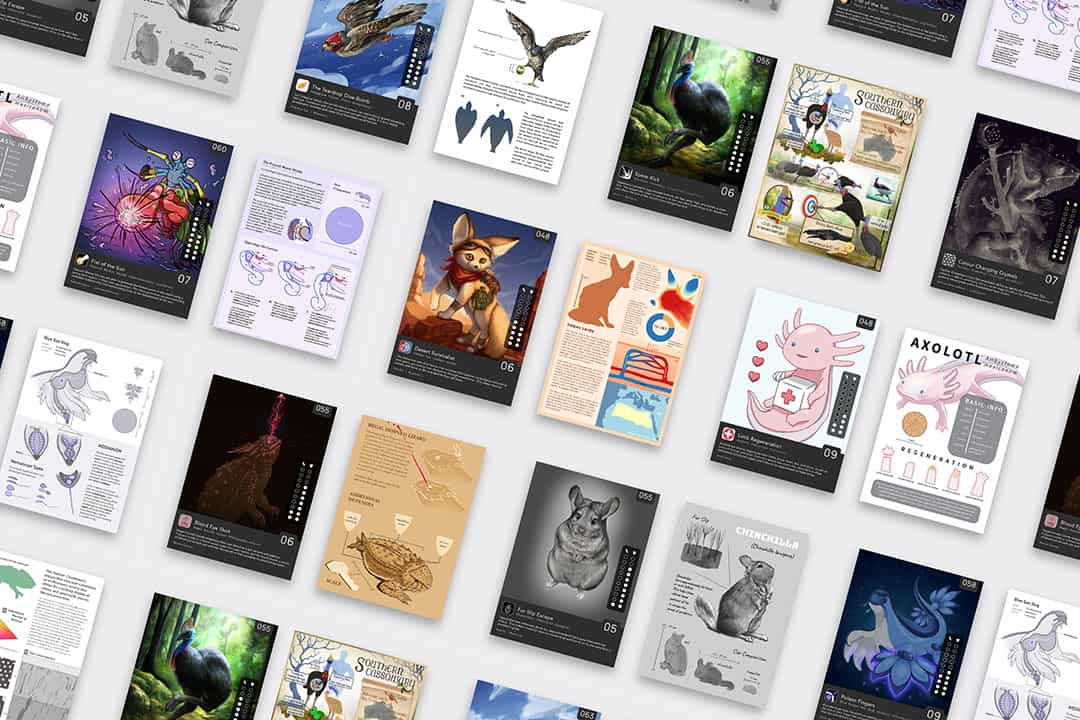If you played with Pokémon cards as a kid, you’ll be thrilled to get your hands on the new BMC SciCards. Michie Wu and Shehryar Saharan, two biomedical communications (BMC) students from UTM, have created beautiful, dynamic trading cards featuring animals with unique real-life abilities. The BMC SciCards were a collaborative extracurricular project for Wu and Saharan, which they described in an interview with The Varsity as a “fun spin-off of Pokémon cards.”
The goal for these cards, as described by both Wu and Saharan, was to “communicate the science or special abilities of real animals,” while also being a way to connect with incoming students to their master’s program at UTM — biomedical communications, which is affectionately known as BMC to its students. The two-year program is one of a kind, and focuses on scientific visualization using various media, including traditional and digital methods of creating art.
“We started this all on our own. We were just talking and we were thinking of ways to collaborate together,” Wu said. The pair noted that they were lacking collaborative projects in the first year of their program due to its online nature, and wanted to explore different ways to get eager incoming students acquainted with BMC.
The result of their brainstorming was a series of cards by Wu, Saharan, and a few other BMC students that showcase interesting animals rendered in each artist’s unique style, with descriptions of their most notable features and abilities on the back of the cards. “We had a lot of online meetings,” said Wu. “We’d have weekly meetings that were scheduled with each other just for SciCards.”
For his SciCard, Saharan chose to draw and represent the panther chameleon, a beautiful, complex creature whose skin has the ability to change colour. Saharan said that he’d always wondered how the chameleon can change the colour of its skin and was pleasantly surprised when he started researching it. “It turns out it has multiple skin layers that expand and retract, and there’s pigment that’s released. So there’s a combination of really interesting scientific mechanisms that happen at the microscopic scale that allow it to change colour within seconds,” he explained.
Saharan’s piece was drawn traditionally using a method called “carbon dust.” Then, he scanned the drawing into a digital program to add alterations as desired. This flexibility between both traditional and digital mediums allows for artists to develop their own unique, hybrid style.
Wu chose to represent a similarly beautiful animal, the blue dragon sea slug. “What it does is it ingests these tiny, tiny organisms that live within it. And these organisms live within its fingers, basically, like appendages that are off its main body,” she explained. She added that the organisms shoot out of the slug’s fingers as a defence mechanism.
Wu and Saharan often get to exercise both their scientific backgrounds and their artistic skills in BMC. When they can’t find scientific diagrams that comprehensively explain certain mechanisms, they can take advantage of their skills and create visuals that explain these processes in a succinct manner.
As for the SciCards, Wu and Saharan hope for this to be an annual endeavour. They hope that incoming students will participate in the project and make their own cards, to grow the project year by year. Saharan hopes to see a larger collection of BMC SciCards in the coming years.
“We’ve already got the first set printed, and it’s going to go into the incoming welcome package for next year’s students, so hopefully it gets them interested in the project.” said Wu.


